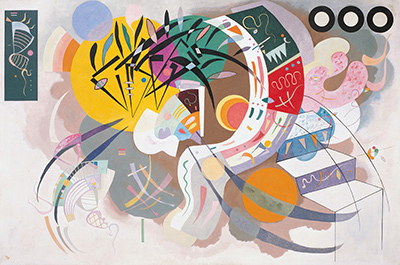Kandinsky had always shown an interest in abstract art, so it was a natural progression for spots and lines to gradually replace brightly-coloured landscapes.
After involvement in two other groups, Kandinsky co-founded Blue Rider or Blaue Reiter in 1911. The First World War meant a temporary absence from Germany, while his membership of the Bauhaus group in the 1930s, closed down by the Nazis for encouraging decadent art, forced a permanent move to France, where he produced Dominant Curve in April 1936.
The artist's fascination with the organic sciences found its way into his paintings, and during his Bauhaus period, he mounted illustrations taken from scientific papers.
In addition, he owned books depicting microscopic creatures, likenesses of which appear in Dominant Curve. Three small circles in the top right hand corner sit above a pink embryo, opposite a green rectangular shape that seems to house tiny marine animals, while some viewers see human faces and forms in the picture.
Steps on the right lead to nothing obvious, but may symbolise reaching out to a higher spiritual plane. This is a nod to Schröder's Staircase, a 19th century reversible diagram that was much reprinted in psychology books, and that was open to a variety of interpretations. In fact, there are several readings possible here, as in some of Kandinsky's other compositions.
The artist's mature works take on themes of transformation together with re-birth, and the harmony and light of Dominant Curve was a picture that Kandinsky felt to be one of his most significant. The middle of the canvas explodes outwards and the whole surface bristles with movement and re-generation, but it doesn't lose that lightness of touch which characterised his creations in that period.
On leaving Germany, he moved on from the geometric restrictions of his Bauhaus days and embraced lighter touches incorporating organic images, although he still retained some use of curves and lines, as in this composition. In this, he was influenced by surrealists such as Jean Arp and Joan Miró, with more humorous subjects being a result of his association with friend and fellow Bauhaus collaborator Paul Klee.
From arrival in Paris until the year of this painting, Kandinsky had been experimenting with a mixture of sand and pigments, a method used in France in the 1930s by Georges Braque and others, producing richly textured canvases.
As a musician as well as an artist, Kandinsky found that when he listened to music, he "saw" colourful images in his mind. He often gave his paintings titles that suggested musical terms, and was convinced that colour could provide a visual expression to aspects of music. Although Dominant Curve has no direct musical meaning, the colours and shapes seem to constantly shift in the way that a musical piece might also develop.
Born in 1866 in Moscow, Wassily or Vasily Kandisky swapped his boyhood interest in art for a career in law, only leaving to paint full time at the age of thirty. After some frustrating time at art school in Munich, he travelled across Europe with his second wife, eventually settling in Bavaria.




